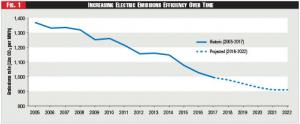Revisit Our Metrics
Keith Dennis is Senior Director of Consumer Member Engagement at The National Rural Electric Cooperative Association (NRECA). He is also a Board Member of the Beneficial Electrification League. The views expressed are solely his and not of the associated organizations.
Energy efficiency programs are widely acknowledged as one of the most important achievements of the energy industry. They have enjoyed widespread political and popular support when implemented in cost-effective ways that save consumers money.

Their success to date should be commended, and we should continue to avoid energy waste. But if we are going to match the success of the past, our energy efficiency programs will need to adapt to keep up with changes across the energy industry landscape.
Today's end-use energy efficiency programs are largely made up of legacy programs from the 1970s oil embargo era. Because energy security was a paramount concern, the policy driver for efficiency programs was conserving primary or total energy.
As concerns about climate change have come to the fore for many policymakers, energy efficiency programs increasingly have been used as a tool to reduce greenhouse gas emissions. According to the Department of Energy, "energy efficiency is one of the easiest and most cost-effective ways to combat climate change, clean the air we breathe, improve the competitiveness of our businesses and reduce energy costs for consumers."
Simply stated, energy efficiency program models have not kept up with the shifting goals. At a high level, these programs are being used to provide emissions efficiency improvements. It's not a strategy for conserving total energy, rather one to reduce greenhouse gas emissions, in addition to saving money for the consumer.
 Figure 1 - Increasing Electric Emissions Efficiency Over Time
Figure 1 - Increasing Electric Emissions Efficiency Over Time
And since energy can have varying emissions profiles depending on when and how it is produced, we have an increasingly problematic mismatch between the energy-based energy efficiency metrics we use and the emissions-based outcomes we want. We need a change in mindset.
Load shaping, demand response and beneficial electrification often are excluded from consideration in designing energy efficiency programs even though these activities are critical to meeting twenty-first-century challenges.
These activities save consumers money and help reduce environmental impact. It's time to expand the definition of energy efficiency to bring these activities into the fold. Let's look at some examples of activities that have the potential to reduce greenhouse gas emissions and save consumers money but would not be considered energy efficiency under the current approach.
Example 1 - Energy Storage Using Batteries
Consider a home that consumes a thousand kilowatt-hours of electricity per year. Each day, programs help the electric system operate more efficiently and save consumers money by storing energy when that energy is cheap and has lower emissions. For this purpose, the house uses an in-home battery that has a round-trip efficiency of eighty-seven percent.
In other words, the battery loses thirteen percent of the energy it stores, which is typical of large home batteries. Suppose that each day this residential system uses the battery to shift fifty percent of its energy use from a high-cost period to a low-cost period.
From a traditional energy efficiency perspective, this house would be six and a half percent less efficient when making use of the battery because more total energy is consumed by the home. However, it may be much more efficient from a cost perspective and emissions perspective if the energy stored is sourced from renewable, low-marginal-cost resources such as wind.
This use of energy would thus save consumers money, help the grid operate more efficiently, and reduce greenhouse gas emissions (such as, is more emissions efficient), yet would not be considered more energy efficient under the current energy efficiency definition.
Example 2 - Load Shaping Using Water Heaters
An electric water heater uses electricity to heat water each day, and since the hot water is stored in a tank until it is used, it does not matter when the water is heated as long as it is hot when it is needed. Assume there are two options to power a water heater:
Option 1: the water is heated in the early evening when the sun is going down and the electricity cost are high and power plants with relatively high emissions are ramping up to meet electric demand as workers return home.
Option 2: the water is heated in the middle of the night when electricity prices and demand are low and low-emissions nuclear or wind power is abundant.
Under this scenario, a traditional energy efficiency view would find both options equal and may even find option 1 better due to the heat losses of nuclear energy generation. However, since option 2 greatly reduces emissions and lowers cost, it has better emissions efficiency and is a more efficient use of the energy system.
Example 3 - Electrification and Use of Electricity in General
Consider the energy efficiency of an electric vehicle in terms of miles driven per kilowatt-hour or any other electric product in terms of useful output per kilowatt-hour consumed.
Typically, an electric vehicle or other electric appliance's energy efficiency will not change significantly over operating lifetimes. An electric vehicle produced today will operate with roughly the same miles-per-kilowatt-hour in ten years as it does now.
Due to the declining carbon intensity of the grid, however, these devices will become more emissions efficient over time; the electric vehicle will emit less carbon dioxide per mile in year ten than it does today.
See Figure One.
Time for a New Energy Efficiency Metric
Changing the fundamental metric used in measuring efficiency programs would represent a step-change and allow for a broadening of the definition of energy efficiency. Instead of measuring the reduction of "total energy," we should consider measuring greenhouse gas emissions per useful output and the cost to achieve projected reductions, or cost-effective emissions efficiency.
The lower the emissions created per unit of useful output from an energy-consuming service, the greater the "emissions efficiency." For example, fewer pounds of carbon dioxide emitted per mile by a car or fewer pounds of carbon dioxide emitted per gallon of hot water provided by a water heater. When the program or activity intended to reduce emissions also lowers the overall cost to consumers, the activity can be considered cost-effective emissions efficiency.
Changing how we measure and define energy efficiency is not insignificant. We are talking about a paradigm shift, a new efficiency world order. The dogma of the current energy efficiency regime that needs to be revisited includes:
Myth 1: The way to achieve environmental improvement of the energy sector is to use less electricity. It is not the case that the only way to reduce the environmental impact of the electric sector is to use less electricity.
Replacing the use of fossil fuels such as gasoline, diesel, fuel oil, propane, and natural gas with electricity may increase kilowatt-hour consumption but reduce greenhouse gases — a concept known as beneficial electrification.
Myth 2: High electric prices are good for the environment. In the past, some energy efficiency advocates have postulated that higher electricity prices would promote conservation and therefore help meet environmental goals.
But in a marketplace where the choice is between appliances that use emissions-efficient electricity and appliances that burn fossil fuels, electricity prices must be kept low to compete. Higher electricity prices will make direct fossil combustion more cost effective.
Keeping electricity prices low as increasing amounts of renewable resources are integrated into the system is imperative. Load shaping and demand-response programs can help ensure the efficient operation of the grid and provide a cost-savings for consumers.
Myth 3: Total energy is a key metric and as we electrify, total energy use must decrease. In a nod to the old way of thinking about energy efficiency, Electric Power Research Institute's recent U.S. National Electrification Assessment demonstrated that electrification could reduce total energy while reducing emissions and increasing electric production.
If future electrification saves consumers money and lowers emissions, what difference does total energy consumption make? It is simply an artifact of a time when all energy was non-renewable and the goal was keeping fuel stock in the ground.
Times have changed, and our metrics should as well. This change will be uncomfortable for an energy efficiency industry that has established rules and institutions that are upended by increased introduction of renewable, emissions-free electricity generation that was simply not part of the equation when the current energy efficiency regime was developed.
Indeed, over the decades, the energy efficiency industry has grown from a cottage industry to a major force that has achieved remarkable success. While most efficiency professionals support the goal of reducing greenhouse gas emissions, they have not yet revised their views about electricity.
As policymakers and the industry take steps toward widespread electrification of end-uses across the economy, we would benefit from collaboration. The electric utility sector needs to tap the tremendous wealth of knowledge and experience of the energy efficiency community to craft the metrics and cost-effective solutions to implement a new phase of efficiency programs that can better consumers' lives. Together, we can meet the goals of achieving the abundant cost-effective emissions efficiency opportunities.



